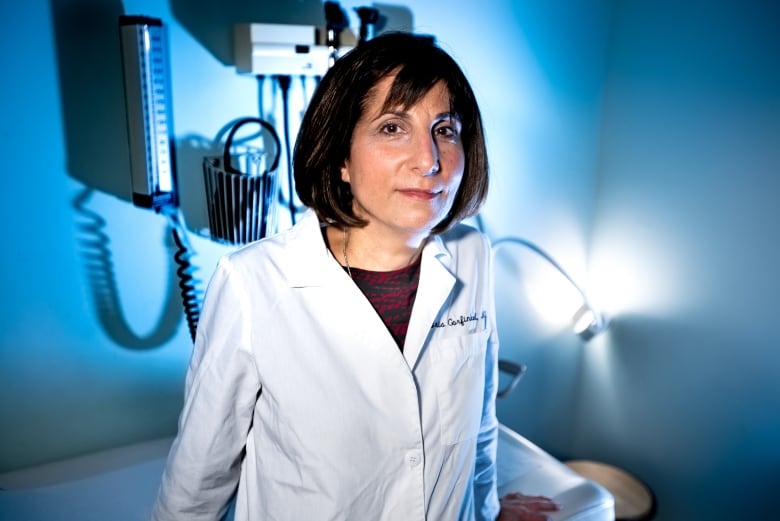This story is part of CBC Health’s Second Opinion, a weekly analysis of health and medical science news emailed to subscribers on Saturday mornings. If you haven’t subscribed yet, you can do that by clicking here.
If you catch the virus behind COVID-19 and you’re at a high risk of serious illness, there’s one major tool in a physician’s arsenal to keep you out of hospital: Paxlovid.
Pfizer’s antiviral drug was hailed as life-saving when it burst onto the scene midway through the pandemic. Clinical trials, conducted on people who’d never been vaccinated, showed it protected those vulnerable individuals from becoming dangerously sick, with a nearly 90 per cent reduction in the risk of hospitalization and death.
But many clinicians agree the COVID landscape has shifted dramatically since early January 2022 when the drug was approved for use in Canada. Now, the vast majority of Canadians have more protection from serious illness through prior vaccination, infection or both.
So where does Paxlovid fit into the treatment picture now? The answer remains murky.
Some doctors warn about patchwork, muddled guidance over who should be eligible for the drug, while others point to a lack of up-to-date research, meaning it’s unclear whether Paxlovid is effective in a population that’s been so heavily exposed to this virus.
At the same time, SARS-CoV-2 is still circulating widely, and remains linked to thousands of hospitalizations and dozens of deaths on a weekly basis. Meanwhile, tens of thousands of treatment packs are sitting unused in provincial stockpiles, raising concerns over whether the people who could still benefit from the treatment are even able to access it.
“[Paxlovid] was, at the time, hailed as a game changer. This was clearly demonstrated with high-quality evidence… and I think it was very appropriate to procure a significant amount of the drug for our country,” said Dr. Nathan Stall, a geriatrician with Sinai Health System in Toronto.
“The thing is, we’ve seen multiple times [that] the pandemic changes — and it changes very quickly. And so I don’t think we should be prescribing drugs because we have supply; we should be prescribing drugs to patients who need it.”
Eligibility varies by province
Nirmatrelvir/ritonavir, sold under the brand name Paxlovid, is an oral combination medication that’s taken for five days and stops the virus from multiplying inside someone’s body.
In Canada, it’s approved for use in adults “who have a high risk of getting severe COVID-19, including hospitalization or death.”
But the definition of who exactly is deemed “high risk” — and therefore eligible to get the drug — varies widely from province to province. Provincial public health teams base eligibility on a mix of factors: age, vaccination status, elapsed time since their last dose, and whether they’re immunocompromised or have other serious health conditions.
Multiple jurisdictions, including Ontario, say vaccinated adults as young as 60 are eligible for a prescription. B.C. doesn’t offer it to most residents under 70 unless they’re behind on their vaccines or have one or more serious chronic medical conditions. Meanwhile Nova Scotia’s public referral form, last updated in October 2023, paints a picture of how complex those layered factors can get, with numerous criteria dictating whether or not someone should get the drug.
“Whenever you see a real mess of guidelines, that means that the data is crummy,” said Dr. Lynora Saxinger, an infectious diseases specialist with the University of Alberta.
The best evidence for Paxlovid is from a time when there wasn’t as much acquired immunity throughout the population, Stall noted. That’s a far cry from today, as research suggests the vast majority of Canadians have been vaccinated, infected or both.
Stall and Saxinger agree there’s a lack of up-to-date research into how well Paxlovid currently works to prevent serious illness within such a heavily exposed population.
Drug likely ‘doesn’t work’ for lower risk groups
Pfizer’s original trials involved both unvaccinated and vaccinated patients. But while the trial in high-risk, unvaccinated individuals made headlines for cutting death rates, the drug company stopped a second trial in standard-risk patients after finding the treatment wasn’t effective in reducing their symptoms.
In short, Paxlovid likely “doesn’t work” for those broader groups, said emergency physician and University of Toronto associate professor Dr. Justin Morgenstern, who said far more research is needed beyond early trials run by the maker of the drug.
One systematic review, published in the medical journal PLoS One, looked at 16 outside observational studies, but all of them ended more than a year ago.
The combined finding, based on research conducted up to October 2022, showed Paxlovid reduced someone’s chance of hospitalization or death by 56 per cent. That finding suggests the drug could be effective in reducing risks for certain groups, the researchers wrote, and results were valid in both “vaccinated or unvaccinated high-risk individuals with COVID-19.”

Still, Saxinger stressed those findings need to be put into context.
“It really does look [like] the overall risk of hospitalization [from COVID] — with a documented positive test — has dropped considerably,” she said. “And so even if you reduce the risk of hospitalization by 50 per cent, it’s reducing it from low to lower, and what does that mean?”
Given the price of Paxlovid is rising to nearly $1,400 US per treatment, according to U.S. media reports, Saxinger stressed that buying large amounts of the drug going forward may not be worth the cost if benefits for most patients prove modest at best.
“Is decreasing your illness by a day worth $1,400, to you, your insurer, the health-care system?” she questioned.
Who’s high-risk now?
The major challenge now for clinicians is figuring out who’s really in need of an antiviral drug at this point in the pandemic — and who can safely skip it.
Stall noted there are several clear risk factors for serious illness, including advanced age, comorbidities and a lack of prior vaccination, while Morgenstern said one of the biggest concerns is people who are severely immunocompromised, including cancer patients undergoing chemotherapy.
But even with those factors at play, both agreed it’s worth having a nuanced conversation with a care provider to figure out if Paxlovid makes sense.
The medical experts CBC News spoke to suggested many healthy, older adults likely won’t benefit much from the expensive treatment course, which may also come with unpleasant, short-term side effects such as a metallic taste, nausea, muscle aches and diarrhea.
On the flip side, there could be genuinely high-risk individuals falling through the cracks due to a variety of barriers, including a lack of COVID testing, challenges accessing primary care providers and limited awareness about the drug.
“I think we’re kind of facing a problem right now, where people who are taking the drugs are not necessarily the ones who truly need it,” noted Saxinger. “And the people who truly need it are not necessarily the ones who are getting it.”
Hundreds of thousands of doses of Paxlovid, a treatment for COVID-19, have gone unused in Canada because of difficulties in getting it to the right patients at the right time.
Barriers to access
Toronto-based family physician Dr. Iris Gorfinkel stressed that Paxlovid must be taken within the first five days of a positive test before too much virus accumulates in someone’s system. That means if patients don’t do at-home rapid testing in a timely manner, they could miss the opportunity.
Even if patients do test on time and ask a doctor or pharmacist about getting Paxlovid, care providers’ hands may be tied by provincial guidelines, added Dr. Jennifer Lush, a family physician in Victoria, B.C.
“I’m still limited by the strict restrictions,” she said. “I had a phone call with a patient who was stable enough to be at home but was very very sick, had other medical conditions that made her concerned, and I wanted to give her Paxlovid — but she missed being eligible by a year.”
Paxlovid also conflicts with a long list of other medications, raising concern among doctors that some higher-risk patients might avoid the drug for that reason, even though there are usually ways to take it safely.
“Sometimes it means holding another medication, or reducing the dose,” explained Ottawa-based pharmacist Shelita Dattani, a spokesperson for the Neighbourhood Pharmacy Association of Canada.

U.S. study suggests more uptake prevents deaths
It’s also unclear whether increased access to Paxlovid could further cut COVID-related deaths in Canada, which are far lower but still happening at a much higher rate among the oldest Canadians.
One U.S. study of a million high-risk individuals found that only 15 per cent who were eligible for the drug actually used it. If half of the eligible patients had gotten Paxlovid, nearly 50,000 deaths could have been prevented, concluded authors of the National Institutes of Health study published in May 2023.
What’s certain here in Canada is that the drug remains in high supply.
Canada bought 1.5 million courses of Paxlovid, enough to treat the same number of people, the Public Health Agency of Canada said in a statement. And the provinces still have ample stockpiles, according to data sourced by CBC News, with many having doled out only a small portion of their shipments by early January.
Newfoundland and Ontario have each used roughly half their supplies, data suggests. Alberta has used nearly a third of its total supply, B.C. has used less than a quarter, and Saskatchewan has only doled out around 11 per cent.
With so much of the drug still available, some physicians say it’s just a matter of getting it to the right people, even if research isn’t moving fast enough to confirm its benefits.
“Maybe clinical studies will come where we learn that Paxlovid isn’t the optimal treatment,” Lush said.
“But the reality is, this is the treatment we have now, [and] it doesn’t feel equitable.”





